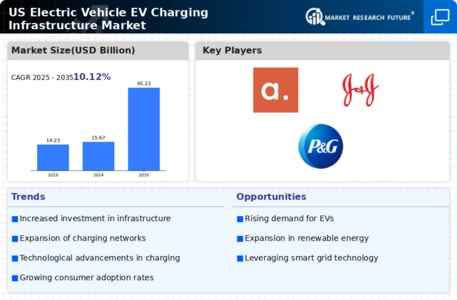Market Growth Projections
The Global US Electric Vehicle EV Charging Infrastructure Market Industry is projected to experience substantial growth over the coming years. With a market value of 15.67 USD Billion anticipated in 2024, the industry is expected to expand significantly, reaching an estimated 45.23 USD Billion by 2035. This growth reflects a compound annual growth rate of 10.12% from 2025 to 2035, driven by factors such as rising electric vehicle adoption, government incentives, and technological advancements. The increasing demand for charging infrastructure is indicative of a broader shift towards sustainable transportation solutions.
Consumer Awareness and Education
Consumer awareness and education regarding electric vehicles and charging infrastructure are vital drivers of the Global US Electric Vehicle EV Charging Infrastructure Market Industry. As more information becomes available about the benefits of electric vehicles, including lower operating costs and environmental advantages, consumers are more inclined to consider EVs as viable options. Educational campaigns by government agencies and non-profit organizations play a significant role in dispelling myths and providing accurate information. This growing awareness is expected to lead to increased demand for charging stations, thereby supporting the market's growth trajectory.
Rising Electric Vehicle Adoption
The increasing adoption of electric vehicles is a primary driver for the Global US Electric Vehicle EV Charging Infrastructure Market Industry. As consumers become more environmentally conscious and seek alternatives to traditional gasoline-powered vehicles, the demand for EVs continues to rise. In 2024, it is projected that the number of electric vehicles on the road will surpass 5 million in the United States alone. This surge in EV adoption necessitates a corresponding expansion of charging infrastructure, which is anticipated to reach a market value of 45.23 USD Billion by 2035, reflecting a compound annual growth rate of 10.12% from 2025 to 2035.
Government Incentives and Policies
The Global US Electric Vehicle EV Charging Infrastructure Market Industry is significantly influenced by government incentives and policies aimed at promoting electric vehicle adoption. Federal and state governments have introduced various tax credits, rebates, and grants to encourage the installation of charging stations. For instance, the federal government offers a tax credit of up to 30% for the installation of EV charging equipment. Such initiatives not only reduce the financial burden on consumers but also stimulate the growth of the charging infrastructure, contributing to an expected market value of 15.67 USD Billion in 2024.
Corporate Sustainability Initiatives
Corporate sustainability initiatives are increasingly influencing the Global US Electric Vehicle EV Charging Infrastructure Market Industry. Many companies are committing to reducing their carbon footprints and transitioning to electric fleets. For instance, major corporations like Amazon and Walmart are investing in EV charging infrastructure to support their electric delivery vehicles. This trend not only enhances corporate image but also contributes to the overall expansion of charging networks. As businesses recognize the importance of sustainability, the demand for charging stations is likely to increase, further propelling market growth.
Technological Advancements in Charging Solutions
Technological advancements in charging solutions play a crucial role in shaping the Global US Electric Vehicle EV Charging Infrastructure Market Industry. Innovations such as fast charging stations, wireless charging, and smart grid integration enhance the efficiency and convenience of EV charging. For example, the development of ultra-fast charging stations can reduce charging times to under 30 minutes, making electric vehicles more appealing to consumers. As these technologies continue to evolve, they are expected to drive investment in charging infrastructure, further supporting the anticipated growth of the market.














Leave a Comment